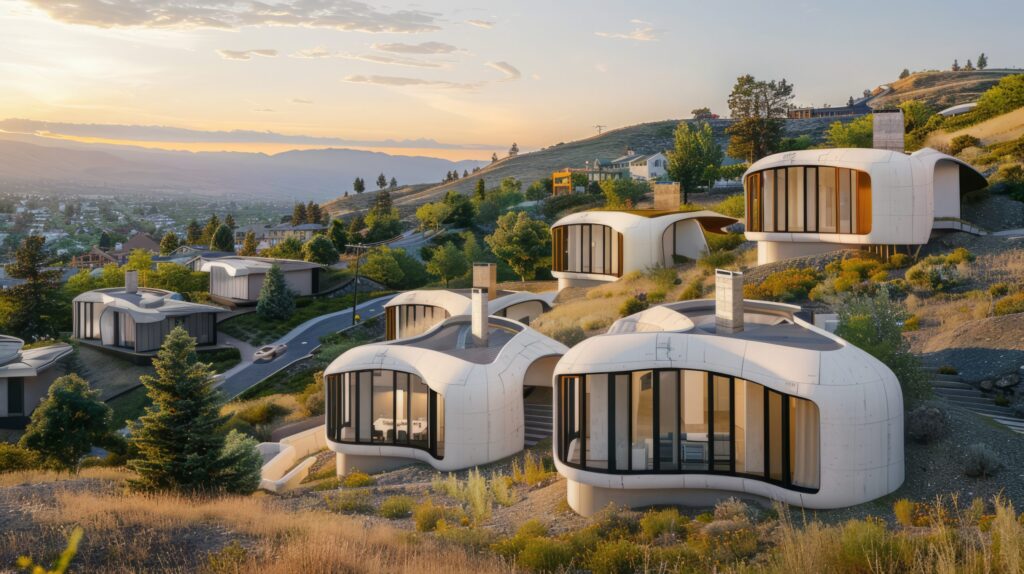The global housing crisis, rising construction costs, and increasing demand for sustainable building solutions have driven innovation in the construction industry. 3D printing technology, once limited to prototyping small objects, is now being used to construct full-scale homes faster, cheaper, and with less environmental impact than traditional methods. By leveraging automation and advanced materials, 3D-printed homes are emerging as a revolutionary solution to affordable housing challenges worldwide.
How 3D Printing Works in Construction
1. The Technology Behind 3D-Printed Homes
- Large-Scale 3D Printers: Construction 3D printers use robotic arms with nozzles that extrude materials such as concrete, clay, or recycled composites in layers to form walls and structural components.
- Computer-Aided Design (CAD) Software: Engineers create detailed digital blueprints that guide the printer, ensuring precision and minimizing material waste.
- Layer-by-Layer Printing: The printing process eliminates the need for traditional formwork and reduces labor-intensive tasks, enabling rapid construction.
2. Materials Used in 3D Printed Homes
- Concrete-Based Mixtures: Special cement blends provide durability and weather resistance while allowing for customization.
- Biodegradable and Recycled Materials: Some 3D-printed homes use eco-friendly materials such as hempcrete or recycled plastic composites to enhance sustainability.
- Insulated and Prefabricated Components: Hybrid models integrate insulation, doors, and windows during printing to create fully functional homes in a single process.
Advantages of 3D Printed Homes
1. Cost-Effective Housing Solutions
- 3D printing reduces labor costs by up to 80%, eliminating the need for large construction crews.
- Material efficiency lowers expenses by reducing waste, as only the necessary amount of concrete or other materials is used.
- Affordable housing projects in low-income regions can be completed at a fraction of traditional construction costs.
2. Speeding Up the Construction Process
- A 3D-printed house can be built in as little as 24 to 48 hours, compared to the weeks or months required for traditional construction.
- Automated printing ensures faster project completion, reducing delays caused by labor shortages or weather conditions.
- Pre-programmed designs allow for mass production of homes, addressing urgent housing needs in disaster-stricken areas.
3. Sustainability and Environmental Benefits
- Reduced material waste contributes to lower carbon emissions, making 3D printing an eco-friendly alternative to conventional construction.
- Some 3D printing projects utilize recycled materials, reducing reliance on non-renewable resources.
- Energy-efficient home designs, including built-in insulation and passive solar heating, further enhance sustainability.
4. Customization and Design Flexibility
- 3D printing allows for innovative architectural designs with organic shapes and curved structures that are difficult to achieve with traditional methods.
- Homeowners can personalize floor plans, interiors, and exterior aesthetics at a lower cost than custom-built conventional homes.
- Adaptive designs can accommodate different terrains, climates, and cultural preferences.
Challenges and Limitations of 3D Printed Housing
1. Regulatory and Legal Barriers
- Building codes and regulations in many countries have not yet adapted to 3D-printed construction, creating challenges in obtaining permits.
- Safety and durability standards for printed homes are still being evaluated in comparison to traditional structures.
2. Material and Infrastructure Constraints
- The strength and longevity of 3D-printed materials require further testing, particularly in extreme climates and seismic-prone areas.
- Current 3D printers are limited to single-story buildings, although research is underway to develop multi-story printing capabilities.
3. Limited Skilled Workforce
- While automation reduces the need for manual labor, trained engineers and operators are required to manage and maintain 3D printing equipment.
- The transition to automated construction will require workforce reskilling and adaptation.
Real-World Applications and Success Stories
1. Social Housing Projects
- Mexico’s 3D-Printed Community: Nonprofits like New Story, in collaboration with ICON and ÉCHALE, have built affordable 3D-printed homes for low-income families in Latin America.
- Netherlands’ Project Milestone: The first fully 3D-printed residential houses have been successfully built and occupied, showcasing the viability of the technology in urban settings.
2. Disaster Relief and Emergency Housing
- 3D-printed homes provide quick and cost-effective shelter solutions for disaster victims in earthquake- and flood-prone regions.
- Relief organizations are experimenting with off-grid 3D-printed homes that incorporate solar panels and water recycling systems.
3. Luxury and Commercial 3D-Printed Structures
- Companies like Apis Cor and Winsun have constructed high-end villas and office buildings using large-scale 3D printers, proving that the technology is not limited to affordable housing.
- Mars Habitat Concepts: Space agencies like NASA are exploring 3D printing for building self-sustaining habitats on Mars and the Moon.
As 3D printing technology advances, it is poised to disrupt the global construction industry. With continuous improvements in materials, multi-story printing capabilities, and regulatory frameworks, 3D-printed homes could soon become a mainstream solution for housing shortages, disaster relief, and eco-friendly urban development. The fusion of automation, sustainability, and affordability makes this technology a game-changer in redefining how we build homes for the future.
From Our Editorial Team
Our Editorial team comprises of over 15 highly motivated bunch of individuals, who work tirelessly to get the most sought after curated content for our subscribers.


